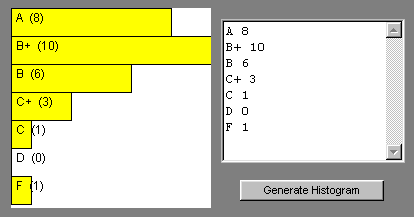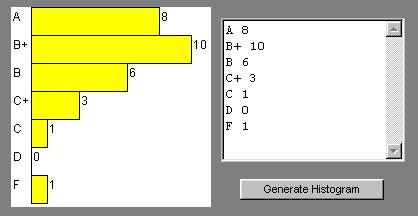CSC 551: Web Programming
Spring 2003
HW4: Java Applets
The Histogram class defines an applet for drawing
histograms in a Web page. The idea is to have the user enter data in a textarea
and then submit that data to the Histogram applet. The applet code will then
parse the data and display the corresponding histogram. For example, the
following screenshot shows a histogram of grades received by a student:

An HTML document that would produce this page is listed below:
|
<html>
<!-- Dave Reed Histogram.html 4/10/03 -->
<head>
<title>Histogram Page</title>
</head>
<body bgcolor="gray">
<form name="HistoForm">
<table>
<tr><td>
<applet name="HistoApplet" code="Histogram.class" height=200 width=200>
You must use a Java-enabled browser to view this applet.
</applet>
</td>
<td align="center">
<textarea name="data" rows=8 cols=20 wrap="virtual"></textarea>
<p>
<input type="button" value="Generate Histogram"
onClick="document.HistoApplet.drawHistogram(document.HistoForm.data.value);" />
</td>
</tr>
</table>
</form>
</body>
</html>
|
Part 1
Copy the source for the Histogram class into a file named Histogram.java
and compile it into byte code. Then create the Web page to serve as an interface
for this applet.
To create and compile an applet using Visual J++, perform the following steps:
- Select Microsoft Visual J++ from the Programs Menu.
- A window titled "New Project" will appear. Select "Applet on HTML" under
the "Web Pages" option in order to create a new applet project, and enter
the name Histogram in the project name box. Also, enter the desired folder for
storing the applet project, then hit the "Open" button.
- This will create a project with default files "Applet1.java" and "Page1.html".
The first thing you must do is change the names of these files. Click on
the + that appears in the Project Explorer window at the upper right. Then
right click on each of the files and select rename to change the names to
"Histogram.java" and "Histogram.html".
- You can then cut-and-paste the code for the
Histogram class into your Histogram.java file.
- To compile the applet, select "Build" under the Build menu.
Cut-and-paste the HTML text above into your Histogram.html document and test its behavior.
You might note that if the user clicks on the button without entering any data in the text area, a Java null-pointer exception is raised. Modify the Histogram.java code so that it catches when the parameter is an empty string. In that special case, the applet window should be cleared. Then, recompile and test your applet in the page.
Part 2
Currently, the labels for the histogram bars are displayed over the bars.
While this is fine for long bars, the label text can be obscured by the edge
of the bar if the bar is short (or the label is very long). Modify the histogram
applet so that the label for each bar appears to the left of the bar, with the
value for that bar appearing to the right. In order to allow enough room to the
left and right of the bars, you will need to determine the maximum number of
characters in a label, and also the maximum number of digits in any value. For
example, given the grades data above, your applet would need to allow space for
2 characters to the left of the bars and 2 characters to the right. If there
were labels with more characters or values with more digits, however, the
applet ought to be able to adjust accordingly. After your modifications, the
page would look like:

Useful hints: Currently, the code in drawHistogram traverses
the data and finds the largest value. You will need to similarly traverse the
data to find the longest label (using the string method length()).
Once you know the longest label, you can multiply by the approximate number of
pixels per character to determine the starting point for histogram bars.
Similarly, you must determine the number of digits in the largest bar value
and multiply by the number of pixels per character to determine the rightmost
limit for histogram bars. In order to determine the number of digits in an
integer value, a handy trick is to first convert the int to a string by
concatenating it with the empty string "", then use the string method
length() (e.g., numDigits = (""+number).length(); ).
When you are testing your code, be aware of the fact that browsers do not
always reload applets when a page is reloaded. Holding down the Ctrl key when you click
on the Refresh button will usually reload the applet. However, there are times
when you must exit the browser
completely (close all windows) then restart the browser in order to load changes.
Part 3
Modify the applet code so that the bars of the histogram alternate colors.
For example, the first bar might be yellow, the second bar green, then yellow,
then green, etc.


